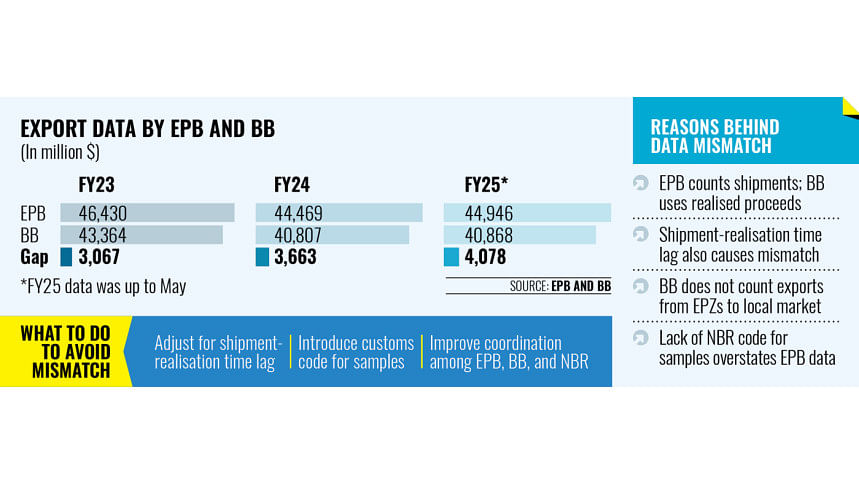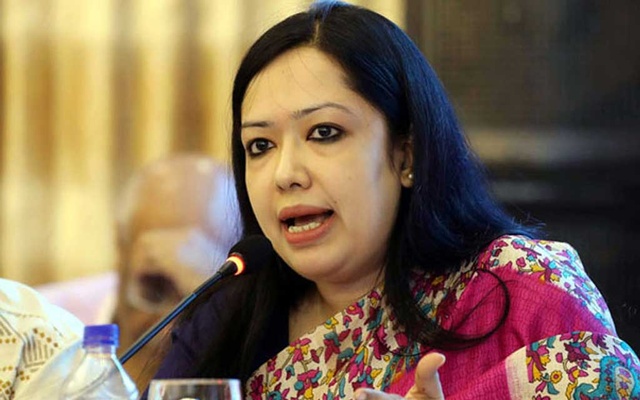
Last update on: Wed Jul 30, 2025 12:44 AM

The gap in export data maintained by the Export Promotion Bureau (EPB) and the Bangladesh Bank (BB) has persisted even though both agencies teamed up last year and began reconciling merchandise shipment figures.
In the fiscal year (FY) 2023-24, the gap in export data between EPB and BB was $3.66 billion. At the beginning of FY25, the central bank adjusted the calculation, while the export promotion agency briefly suspended its monthly data release.
Despite the reset, the discrepancy in export data rose to $4 billion in the first eleven months of FY25, according to figures from BB and EPB.
The mismatch has prompted fresh calls among economists for investigations.
Amid criticism following the revelation of a large mismatch in export earnings data by BB and EPB in mid-2024, EPB suspended the release of export data for three months to identify the causes of the gap.
At that time, it emerged that the difference between export figures calculated by EPB and BB had persisted for at least 12 years, with the gap crossing $12 billion in FY 2022-23.
The central bank corrected its figure in the Balance of Payments (BoP) in July last year, taking economists and business leaders by surprise.
Later, BB identified multiple entries, equivalent to 20 percent of the total dataset. In previous months, the ratio of multiple entries to total exports was 14 percent.
EPB usually compiles export data based on numbers it receives from the National Board of Revenue (NBR) and the central bank.
While resuming export data releases in October 2024, the EPB mentioned the role of the revenue board in the data mismatch. It assured that there would be no data gap between the revenue board and EPB in future.
Prof Mustafizur Rahman, distinguished fellow at local think tank Centre for Policy Dialogue (CPD), said double-counting of export data could be stopped. But the main factor behind the mismatch is shipment value and proceeds realisation — the process by which an exporter receives payment for goods or services that have been exported.
While the central bank uses actual proceeds, EPB counts exports based on shipment, Rahman added.
Sometimes exporters have to give discounts, and some orders get cancelled too, he said. “But the $4 billion gap in export data is quite large. It should be examined.”
Selim Raihan, executive director of the South Asian Network on Economic Modeling (Sanem), said a proper explanation regarding the gap should be given by the agencies to clear up ambiguity.
“Besides, steps should be taken so that the gap can be narrowed down as much as possible,” he said.
POTENTIAL AREAS OF DISCREPANCY
Arief Hossain Khan, a spokesperson of BB, said EPB counts exports based on shipment, whereas they use export data based on realisation. This creates a discrepancy.
On the issue, Abu Mukhles Alamgir Hossain, director (Policy and Planning)-current charge at EPB, said the export figure used by BB in the Balance of Payments (BoP) excludes exports from Export Processing Zones (EPZs) to Bangladesh and cutting, making, and trimming (CMT) charges.
CMT is a manufacturing process where a factory cuts fabric according to provided patterns by the buyer, sews the pieces together to create the garment, and then trims any excess threads to finish the product for shipping.
Hossain said the shipment value of goods used by the central bank in other places matches the EPB figures.
Apart from CMT and local sales by EPZs, he identified two more areas where the counting could mismatch.
Hossain said BB includes exports under merchanting, which means a trader purchasing goods from one country and selling them to a buyer in another country, and goods procured in ports by carriers, such as fuels and supplies, in the export calculation.
Besides, he said there is a time lag between shipment and actual export proceeds realisation.
Additionally, Hossain said in the absence of any code for samples sent by exporters to buyers, the revenue board counts the value of those samples as exports. This problem will be over once the NBR creates a customs procedure code for samples.
“It will be operational soon,” he said, adding that there would be no gap in export data once the Bangladesh Single Window, an electronic gateway enabling businesses to submit documents for imports and exports and clear goods more efficiently, becomes fully operational.









